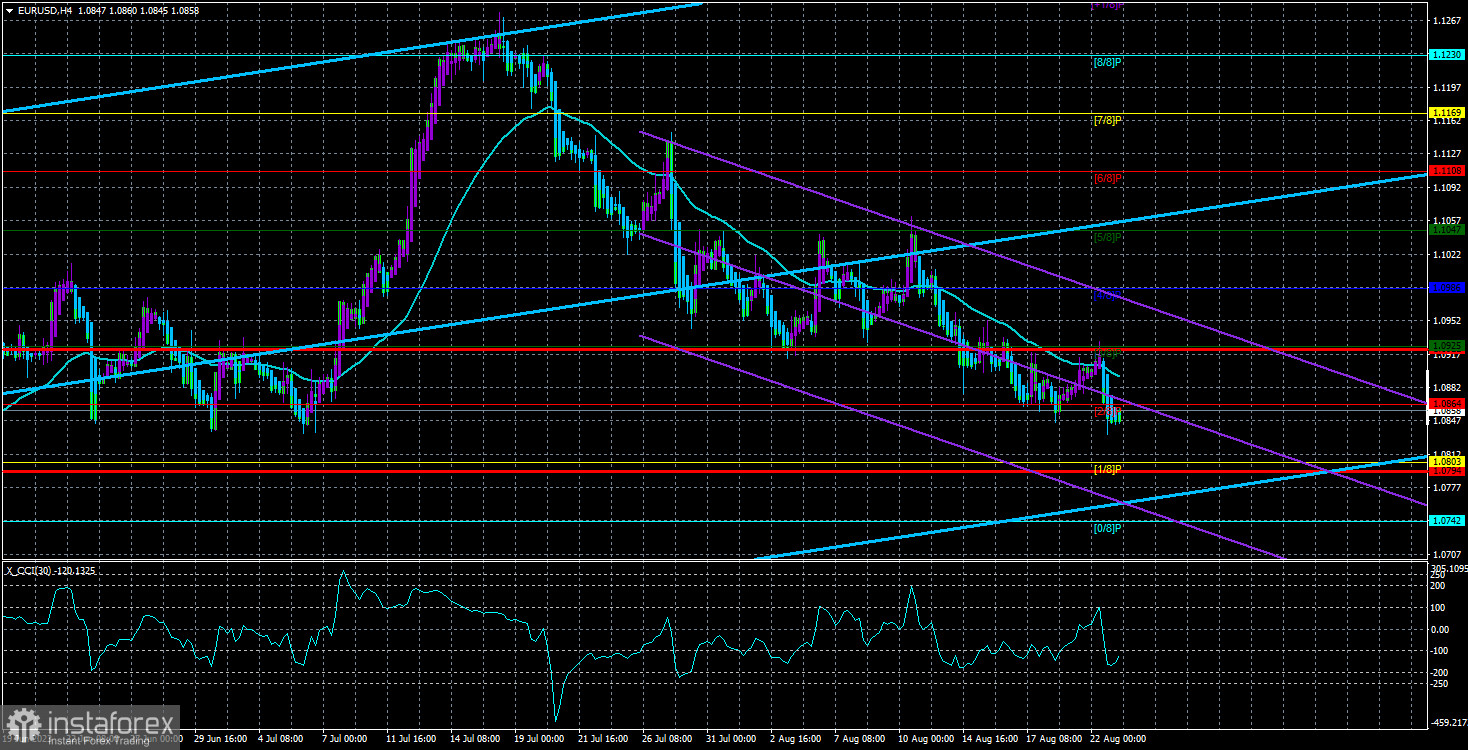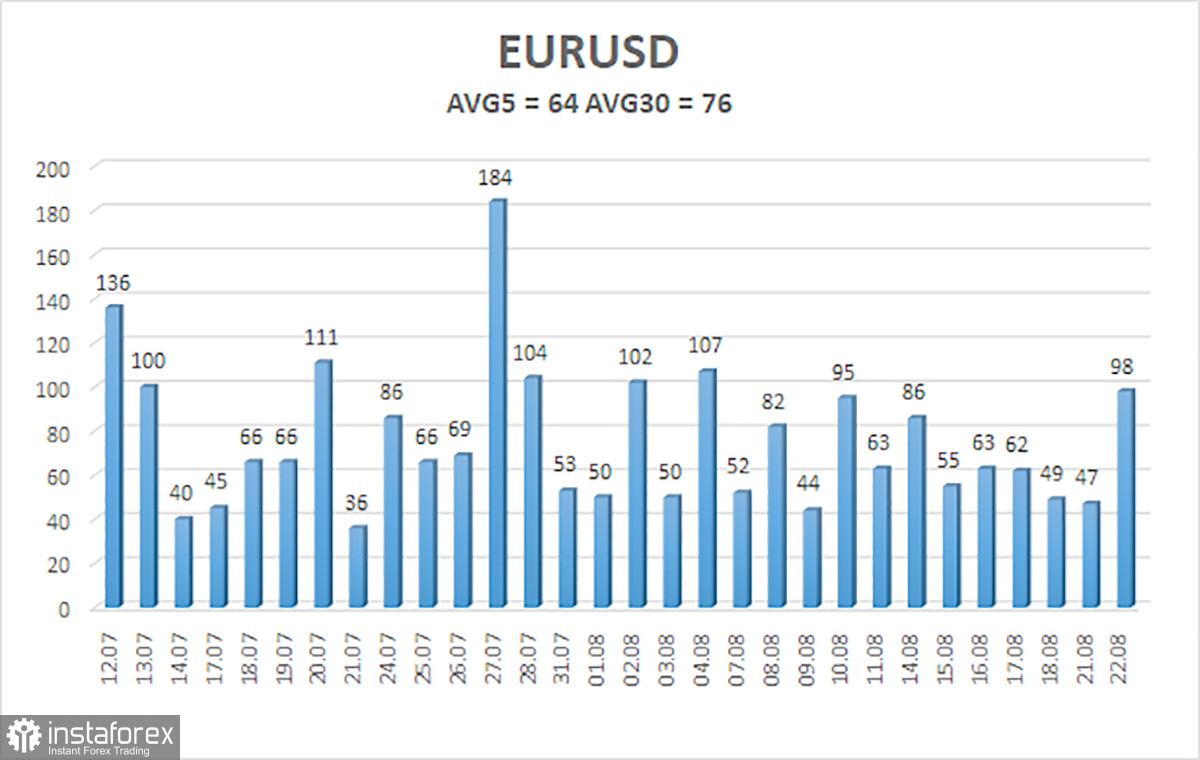
Yesterday, the EUR/USD currency pair rose to its moving average line but almost immediately rebounded and began a stronger decline. This decline eloquently demonstrated who currently dominates the market. Traders shouldn't be misled by the movement toward and potentially beyond the moving average – this line is close to the price (due to low volatility) and can touch it almost daily. However, as we can see, the first attempt to rise above the moving average failed. Importantly, this cannot be blamed on strong macroeconomic data for the dollar or the fundamental backdrop.
Technically, nothing has changed. The pair updated its local minimum yesterday, meaning the downward trend remains. Thus, expecting the European currency to fall is the most logical under the current circumstances. As we have repeatedly stated, there have been no reasons for the euro to grow for a long time. The ECB increasingly signals a potential pause in tightening, and some experts do not anticipate more than one rate hike in 2023. This means the ECB rate will remain much lower than the Federal Reserve. Demand for the dollar will increase since, at present, one can earn much more from bank deposits and treasury bonds in the US than from similar instruments in the European Union. Additionally, inflation in the EU is higher, while it has already dropped to 3.2% in the US.
Besides, it should be noted that the Federal Reserve can also raise its rate again. It has far better opportunities for tightening than the European Union. However, we mentioned several months ago that the ECB is constrained in its monetary moves as it needs to consider the interests of all 27 member countries, some of which are economically weak and cannot withstand overly strict monetary policies.
Lagarde is unlikely to protect the euro from falling.
At this time, the macroeconomic background is irrelevant. It might lift the euro, but we advocate continuing the pair's decline. On Friday, speeches from Christine Lagarde and Jerome Powell are scheduled. If we are mistaken in our assessment of rate changes in the US and EU, the chairpersons of both central banks can convey the true information to the market. However, the symposium in Jackson Hole is not where Lagarde and Powell will be candid and make sensational announcements.
However, a few hints might suffice for the market. The Fed's position is now even less critical than the ECB. If the Fed's rate doesn't increase in September, it will in November. On the other hand, if the ECB pauses in September, it will find itself in a much less favorable position since its rate is significantly lower than the Fed. Hence, ultra-hawkish rhetoric is required from Lagarde for the European currency to start growing again.
On the 24-hour TF (Time Frame), the price has settled below the Ichimoku cloud, but this isn't the case. We are looking at the Senkou Span B line at the 1.0862 level, and there needs to be a clear and confident consolidation below this level. Nonetheless, we also didn't witness a strong upward recoil after this level was tested, meaning the quote decline might continue at a moderate pace.

The average volatility of the EUR/USD currency pair over the last five trading days as of August 23 is 64 points and is characterized as "average." Consequently, we expect the pair to move between the levels of 1.0794 and 1.0922 on Wednesday. A reversal of the Heiken Ashi indicator upwards will indicate a new upward correction phase.
Near Support Levels:
- S1 – 1.0803
- S2 – 1.0742
- S3 – 1.0681
Near Resistance Levels:
- R1 – 1.0864
- R2 – 1.0925
- R3 – 1.0986
Trading Recommendations:
The EUR/USD pair currently maintains a downward trend. For now, staying in short positions with targets at 1.0803 and 1.0794 is advisable until the Heiken Ashi indicator turns upwards. Long positions can be considered if the price consolidates above the moving average, with targets at 1.0986 and 1.1047.
Illustration Explanations:
- Linear regression channels help determine the current trend. The current trend is strong if both are pointing in the same direction.
- Moving average line (settings 20.0, smoothed) determines the short-term trend and the direction in which trading should proceed.
- Murray levels are target levels for movements and corrections.
- Volatility levels (red lines) are the probable price channel in which the pair will operate over the next day, based on current volatility indicators.
- CCI Indicator – Its entry into the oversold area (below -250) or the overbought area (above +250) indicates an impending trend reversal in the opposite direction.
 English
English 
 Русский
Русский Bahasa Indonesia
Bahasa Indonesia Bahasa Malay
Bahasa Malay ไทย
ไทย Español
Español Deutsch
Deutsch Български
Български Français
Français Tiếng Việt
Tiếng Việt 中文
中文 বাংলা
বাংলা हिन्दी
हिन्दी Čeština
Čeština Українська
Українська Română
Română

